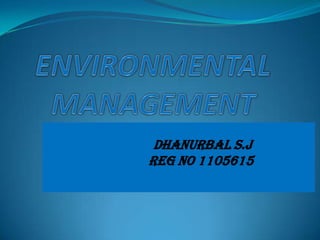
Radio active waste management
- 1. DHANURBAL S.J REG NO 1105615
- 3. INTRODUCTION Certain elements that compose matter emit Radio particles and radiations spontaneously. This activity phenomenon is referred to as ‘radioactivity’ Three different kinds of rays; Alpha, Beta and Gamma rays are associated with radioactivity. The alpha rays consist of particles (nuclei of helium atoms) carrying a +ve charge, beta rays particles have –ve charge (streams of electrons) and gamma rays are charge less EM radiation Radioactive elements decay at different rates. Rates are measured as half-lives – that is, the time it takes for onehalf of any given quantity of a radioactive element to disintegrate. The longest half-life is that of the‘isotope’ 238U of uranium. It is 4.5 billion years. Some isotopes have half-lives of years, months, days, minutes, seconds, or even less than millionths of a second.
- 4. Penetration of radioactive rayz
- 5. Introduction Radioactive wastes are waste that Radio active contain radioactive material. waste Radioactive wastes are usually by- products of nuclear power generation and other applications of nuclear fission or nuclear technology, such as research and medicine. Radioactive waste is hazardous to human health and the environment, and is regulated by government agencies in order to protect human health and the environment. So for the disposal of this radio active waste lot of steps are needed
- 6. TYPE OF RADIO ACTIVE WASTE HIGH LEVEL WASTE…. INTERMEDIATE WASTE…. LOW LEVEL WASTE….
- 7. LOW LEVEL WASTE Low level waste (LLW) is generated from hospitals and industry, as well as the nuclear fuel cycle. LLW typically exhibits no higher radioactivity Low level nuclear waste represents about 90% of all radioactive wastes. Low-level wastes include paper, rags, tools, clothing, filters, and other materials which contain small amounts of mostly short- lived radioactivity. low level wastes are less dangerous than the chemical and organic wastes from our homes that are sent to municipal landfills.
- 8. INTERMEDIATE WASTE It contains higher amounts of radioactivity and in some cases requires shielding. It typically comprises resins, chemical sludges and metal fuel cladding, as well as contaminated materials from reactor decommissioning. It makes up some 7% of the volume and has 4% of the radioactivity of all radio active waste.
- 9. HIGH LEVEL WASTE (HLW) It is produced by nuclear reactors. It contains fission products and transuranic elements generated in the reactor core. It is highly radioactive and often thermally hot. It is very radioactive and, therefore, requires special shielding during handling and transport The amount of HLW worldwide is currently increasing by about 12,000 metric tons every year, which is the equivalent to about 100 double-decker buses
- 10. TYPE OF ATOMIC WASTE DISPOSAL GEOLOGICAL DISPOSAL REPROCESSING TRANSMUTATION SPACE DISPOSAL
- 11. GEOLOGICAL DISPOSAL The process of geological disposal centers on burrowing nuclear waste into the ground to the point where it is out of human reach. There are a number of issues that can arise as a result of placing waste in the ground. The waste needs to be properly protected to stop any material from leaking out. Deep borehole disposal: is type of geological disposal, it means disposing of high-level radioactive waste from nuclear reactors in extremely deep boreholes. Deep borehole disposal seeks to place the waste as much as five kilometers beneath the surface of the earth
- 13. REPROCESSING Reprocessing has also emerged as a viable long term method for dealing with waste. As the name implies, the process involves taking waste and separating the useful components from those. Specifically, it involves taking the fissionable material out from the irradiated nuclear fuel.
- 14. TRANSMUTATION Transmutation specifically involves converting a chemical element into another less harmful one. Common conversions include going from Chlorine to Argon or from Potassium to Argon. The driving force behind transmutation is chemical reactions that are caused from an outside stimulus, such as a proton hitting the reaction materials. Natural transmutation can also occur over a long period of time. It also serves as the principle force behind geological storage
- 15. SPACE DISPOSAL Space disposal has emerged as an option, but not as a very viable one. Specifically, space disposal centers around putting nuclear waste on a space shuttle and launching the shuttle into space. Problems:- The amount of nuclear waste that could be shipped on a single shuttle would be extremely small compared to the total amount of waste produced. The possibility of the shuttle explotion.
- 16. CONCLUSION Various methods exist for the disposal of nuclear waste. A combination of factors must be taken into account when assessing any one particular method. The volume of nuclear waste is large and needs to be accounted for. The half-life of nuclear waste results in the necessity for any policymaker to view the time horizon as effectively